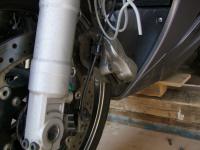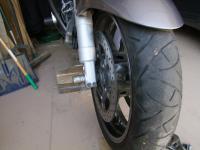Hello FJR AE owner,
I plan to change the front tire in the next month or two. Page 4-17 of the service manual calls to:
1. Disconnect the front wheel sensor coupler, believed to be underneath the gas tank. Is this really necessary?
2. Remove the front brake disc (rotor). I want to have the dealer shop to change and balance the tire so wonder if the rotor (and wheel bearing?) really needs to be removed.
What else should I inspect, replace and lubricate for this occasion?
Thanks,
1. Sensor. No need to do anything under the tank.
2. No, leave the wheel as it comes off the bike, just make sure to remove the spacer from the right side. Don't even think about removing the brake rotors, bearings or seals.
A brief(?) how-to:
Undo the screw holding the sensor to the wheel, near bottom centre of this pic
(click on image for larger view)

Then pull the sensor out. BUT ...
You will probably find it's seized in there, in which case put the screw back in, the wheel can be removed without, but it's slightly more fiddly, and you'll have to free up the sensor'e wire higher up by undoing a couple of clips higher up, you'll see when you get there.
Bike on centre stand, jack up under the headers (or put some bags of cement on the pillion seat) to lift the front off the ground. I slip some wood under the front tyre, not to hold up the bike, but to take the weight of the wheel when it's freed.
I usually stick a big note over the brake lever to make sure I don't squeeze it while the wheel is off.
Undo the four screws holding the brake callipers to the forks (two each side), slide them back and manoeuvre them out. It's tight, but they will come out. It's suggested you tie these up to prevent hanging them from their hydraulic lines.
I find it easiest to remove the front mudguard (American English: fender) by undoing the four screws, two each side, in front and behind the forks. The mudguard will slide out through the front. I suggest a layer of rag to prevent scratching as it's drawn forward.
Undo the big nut on the left side, slacken the four pinch bolts at the bottom of the forks, now the axle will drift out. I usually start it by putting the nut on a few turns, then hammering the nut with a block of wood (I don't possess a rubber mallet), then remove the nut and drift the spindle out using a large screwdriver.

When the spindle comes out the wheel will free, but may require some wriggling particularly if you couldn't remove the speed sensor. There will be a spacer on the right, and the sensor housing on the left. Note the sensor housing has a notch to engage with the fork, this must be put back in the correct orientation when re-fitting.
IF THE SENSOR DIDN"T COME OUT OF THE HOUSING, DON"T PUT ANY STRAIN ON ITS WIRE. TIE THE SENSOR HOUSING UP.
The speed sensor housing pulls out of the left side of the wheel, a spacer from the right.
While off the bike, clean out the brake callipers, but
don't squeeze either brake lever. You can take the opportunity to remove the pads, check their wear (several threads around, one contribution I made in a recent thread
here) and clean up.
If you're transporting the wheel, don't lie it on its side so that the brake disks are taking its weight, put a couple of blocks of wood under the rim. (Many moons ago I was told that you could warp the rotors, don't know if I believe it, but better safe than vibrating brakes.)
I clean off the spindle and smear a little grease on it as a rust preventative.
When you come to replace the wheel, ensure its spindle seals are clean, smear a little lithium-based grease (I use Castrol LM 'cos that's what I've got) in round the inner surface of the seals. Put in the right spacer, and, if the speed sensor and its housing stayed together, it will need fiddling into place as the wheel is offered up and the spindle pushed through.
Push the spindle in from the right, it may need gentle tapping, but if it comes up to anything solid, move the wheel to improve alignment. Make sure the sensor housing is aligned to the fork correctly, it's easy to get it wrong and jam the notch in the wrong place. I find this the trickiest part of the whole procedure.
I put a little copper grease on all threads during re-assembly.
With the spindle in place, tighten the big nut to 66 ft-lbs. I don't have a torque wrench, so I tighten it to a mid-to-high grunt tightness.
Some people suggest leaving the pinch bolts until the bike's weight is on the front wheel and the forks are "exercised" by pushing down with the brake on. Either now or then, tighten the left fork's pinch bolts, inner first, then outer then repeat the inner, do them in one shot to 15 ft-lbs, without intermediate tightening (I'm quoting the manual here). Without a torque wrench, I do them up to a moderate tightness. Don't over-tighten, they're into aluminium threads. Make sure the spindle end is flush with the right fork, tap it until it is if necessary. Then tighten the right fork's pinch bolts in the order outer -> inner -> outer.
Check the sensor housing alignment, replace the sensor (if taken out) using a little copper grease to attempt to stop it seizing if it hasn't already, replace the brake callipers and the mudguard. Check the sensor wire retaining clips are all in place.
Squeeze [edit] the front brake lever both brake levers [/edit] a couple of times until the brakes work
before removing the bike from the stand, saves a nasty surprise later.
If a visual shows everything in order, all screws and nuts tight, remove any wood from under the front wheel, take the wife sacks of cement from the pillion seat and you're good to go.
[edited thanks to HotRodZilla's comment below]





